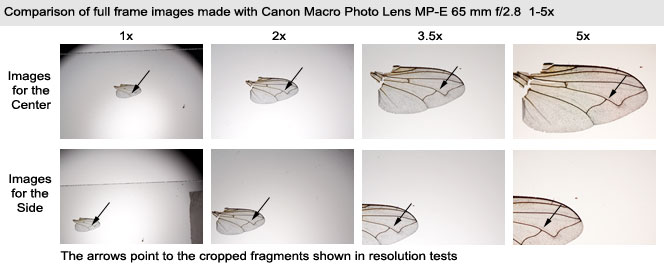 |
|
Canon Macro Photo Lens MP-E 65 mm f/2.8 1-5x
| Aperture Range [f] | 2.8 to 16 (16.8 to 96) see the table below | Closest Focus | 0.24m / 0.8 ft. |
| Dimensions | 98mm x 81mm / 3.8 in. x 3.2 in. | Magnification Ratio | 1 - 5x / 1:1 - 5:1 |
| Weight | 710g / 25 oz | Filter Size | 58mm |
This lens has been designed exclusively for macro shooting, with the lowest possible magnification of 1:1 and various, other than officially specified apertures, shown in the table below.
Test macro. A house fly wing has been placed between two microscopic slides and sealed tightly to flatten it as much as possible. A source of light (flood matte bulb) was placed behind the slide. Two photos on manual focusing (at ISO 50) were made at each f-stop, with mirror locked up, one that placed the wing in the center of the frame and another on the side, approximately 15 mm from the center, as shown below.
The lowest actual magnification ratio: 1.016 : 1
Max. area:
23.70 x 35.43 mm
1 pixel = 6.33 micrometerThe highest actual magnification ratio: 5.05 : 1
Max. area:
4.78 x 7.13 mm
1 pixel = 1.28 micrometer
A millimeter grid paper was photographed and the size-reduced images are presented below. The thumbnail on the right is a collection of the 200x200-pixel cropped images made at various magnifications and f-stops (over a 0.5M file).
The table below summarizes at what f-stops the lens achieved the best sharpness.
Due to the significantly higher actual f-stops than indicated on the lens the best sharpness was achieved at lower f-stops than usual.
Chromatic aberration is virtually non-existent. At the best quality apertures the sharpness is very uniform throughout the entire frame, so that even one micrometer-size details may be spotted anywhere on the image at the full magnification, so practically this lens has optical quality of a good microscope. Of course, there is a big problem with a shallow depth of field (DOF) at high magnification settings, so that making several pictures from a slightly different distance and then combining the images with a software to make good depth of field is essential. Examples are given on this and the following pages (once there click on the "Next Picture").
This is the best quality macro lens Canon has to offer. The image quality it delivers surpasses Canon's 180 mm macro lens. The only draw-back is the lowest magnification ratio, that is still very high, so that for the objects taller or wider than one inch you must use other lenses. Contrary to a common opinion that you have to have a specialized macro flash, I still got away without it and doing just fine, but I can't imagine not having the software that efficiently enhances the DOF. This is true, however, that the distance between the object and the lens must be low (10cm for 1:1 and 4cm for 5:1), so that a lens with a longer focal length would be much easier to use with an external flash system. It is an excellent choice for a serious macro work.
© 2009 PikesPeakPhoto. All rights reserved.